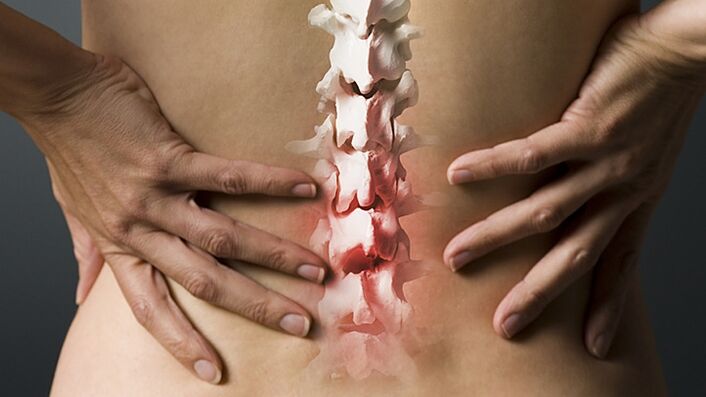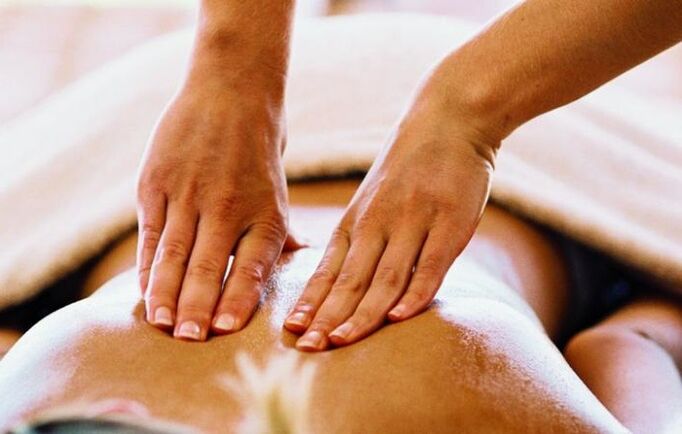
Spinal osteochondrosis is a disease characterized by degenerative-dystrophic changes in the vertebrae and intervertebral discs.
Scientists call this disease a "disease of civilization", as it is associated with a person’s upright posture and the increasing load on the spine in the modern world. Typically, osteochondrosis begins to develop in young people aged 20-25 years.
cause
The exact cause of the development of spinal osteochondrosis has not been established. Experts point out the factors that contribute to its development.
Traumatic factors. Persistent overload (microtrauma) of the spine contributes to accelerated wear of the spinal discs. Antifysiological posture (working in a bent position for a long time, staying long in one position) leads to the formation of subluxations in the intervertebral joints.
Developmental pathology of the musculoskeletal system. Flat feet, shortening of one leg, vertebral lumbarization and other similar pathologies increase the load on the spine and, consequently, accelerate the degenerative process.
Age factor. The development of spinal osteochondrosis is considered by many doctors as a manifestation of the natural aging of the human body.
Vascular factors. A link has been established between the decrease in blood flow (ischemic process) and the acceleration of pathological processes in the spine.
Factors of changes in hormone levels. Natural hormonal changes in the body (pregnancy, lactation, menopause, menopause) cause an increase in degenerative processes.
Endocrine-hormonal disease factors. Diseases such as obesity, diabetes mellitus, myxedema (inflammatory lesions of the thyroid gland) and others contribute to the development of spinal osteochondrosis.
Classification and symptoms
Symptoms depend on the localization of the pathological process.
Osteochondrosis of the cervical spine. The cervical spine contains blood vessels that feed the brain. With degenerative changes in this part, the organs of the head are not adequately supplied with blood. This often leads to cerebrovascular accidents.
The main symptom of osteochondrosis of the cervical spine is headache. This pain is usually permanent, worse in the morning and with movement. It arises at the back of the head and removes the parietal-temporal area. Pain syndrome is often accompanied by dizziness, blinking in front of the eyes of "flies", colored spots.
In addition, pinching the nerves often contributes to the appearance of scalp, sore throat, and neck pain. Pain syndrome sometimes catches the arms, shoulders. It can be weakened or intensified by turning the head or changing body position.
Signs of cervical spine osteochondrosis include:
- fluctuations in blood pressure;
- ringing in the ears, hearing impairment;
- visual impairment;
- violation of coordination of movement and gait;
- hoarse or weak voice;
- tooth decay;
- snoring during sleep.
Osteochondrosis of the thoracic spine. Manifestations can vary and depend on the localization of the disease, its severity. Compression of the thoracic nerve root leads to intercostal neuralgia. It is indicated by acute pain in the chest, which becomes more intense with inhalation, some movement, coughing, and laughing. The pain syndrome worsens after a person stays in one position for a long time or after doing physical exercise. Osteochondrosis of the thoracic spine is often the cause of diseases of the stomach, lungs, heart and other human organs.
Osteochondrosis of the lumbar spine. It often strikes people who spend a lot of time at "sedentary work" (drivers working at computers).
Symptoms of osteochondrosis of the lumbar spine are the character of a painful pain, which increases with sudden movements (lifting weights, sneezing, coughing) and prolonged stay in one position. After a bent position, it is difficult for the patient to straighten his back, sometimes severe pain interferes with even moving. The pain is significantly reduced in a horizontal position of the body. Squatting or lying on a healthy side brings relief.
The pain syndrome in lumbar spine osteochondrosis is often localized in the lower back, radiating to the legs, sacrum, and often to the pelvic organs. Overloading the spinal muscles due to awkward movements, lifting weights causes back pain. Lumbar osteochondrosis of the spine is often indicated by impaired sensitivity, numbness in the area of pain. Patients may experience a tingling sensation, "running crawling. " Often, spasm of the arteries of the legs, a drop in skin temperature on the feet, and coldness of the feet add to the symptoms. Some patients experience dryness and peeling of the skin, sweating disorders.
If you think that you have osteochondrosis of the spine and the characteristic symptoms of this disease, then you should seek the advice of an orthopedist or therapist.
Treatment

The therapy of this disease aims to eliminate pain, restore spinal function, prevent the development of dystrophic pathology in the spine.
The duration of treatment for spinal osteochondrosis depends on the severity of the disease, the age of the patient, and the method of treatment.
In the complex treatment of this disease, the following methods of therapy are used.
- Physiotherapy. It is one of the main methods of treating osteochondrosis. Physiotherapy training includes joint gymnastics and exercises on rehabilitation equipment. The result is a normalization of intervertebral disc nutrition, metabolism, proper muscular corset formation and a decrease in load on the spine.
- Physiotherapy. This method uses effects on the laser body, ultrasound, magnetic fields, low frequency currents for treatment. Due to the use of physiotherapy, the duration of treatment is significantly reduced, and its effectiveness is increased.
- massage. An effective method of relieving muscle pain, tension, improving blood circulation, general strengthening of the body.
- Manual therapy. This method of treating spinal osteochondrosis makes it possible to restore normal mobility of organs, improve blood supply, lymph circulation, and prevent disease progression.
- Traction of the spine. With the help of special equipment, the intervertebral space is increased. This helps restore the proper shape of the spine, relieving pain.
- Reflexology. It consists of the effects of special techniques on acupuncture points and reflexogenic zones of the human body.
Surgical treatment of spinal osteochondrosis is carried out with the ineffectiveness of conservative therapy or for special indications. The amount of surgery depends on the extent of the lesion and the symptoms of the disease.



































